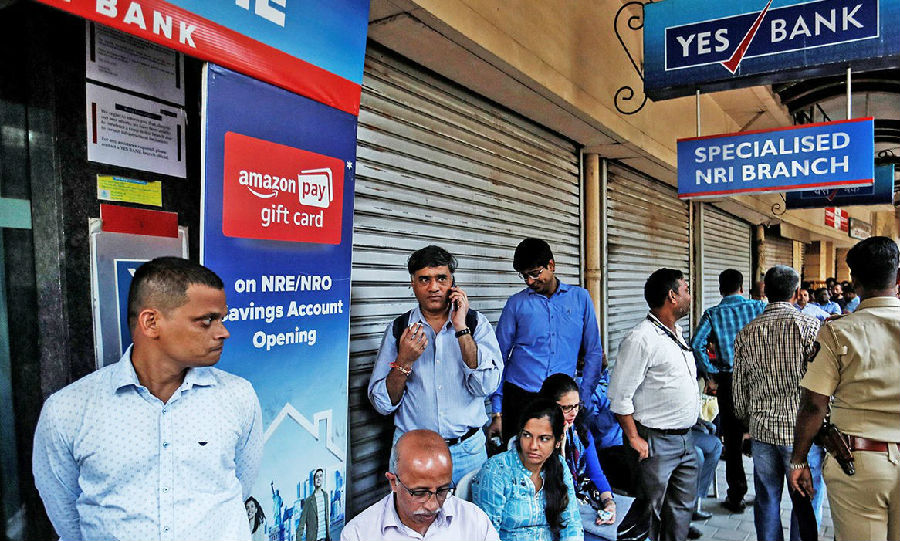India, which has few declared cases of covid-19, has not escaped the turmoil in global markets.
印度幾乎沒有公布covid-19病例情況,但也未能逃脫全球市場的動蕩。
On March 9th its stock-markets suffered their biggest one-day fall in absolute terms ever,
3月9日,盡管低油價會對一個能源進口大國產生積極影響,
notwithstanding the positive impact low oil prices should have on a big energy importer. Its problems go beyond people's health.
但印度股票市場的絕對價值卻出現了有史以來最大的單日跌幅。印度的問題遠不僅是人民健康的問題。
On March 6th a different crisis came to a head when a government-controlled but publicly listed lender,
3月6日,當一家由政府控制的公開上市銀行——印度國家銀行(SBI)
State Bank of India (SBI), threw a lifeline to Yes Bank, once a darling of the stock-market,
向曾經的股市寵兒Yes銀行拋出了救生索,另一場危機到了緊要關頭,
which now faced a scramble to withdraw deposits. It was India's second banking scare in six months.
后者現在正面臨擠兌。這是印度6個月來出現的第二次銀行業恐慌。
It raises questions about who is safeguarding the financial system.
這引發了有關誰在保護金融體系的問題。
Yes's problems are hardly new. As far back as 2013 concerns were raised by a small group of sceptics at the Reserve Bank of India (RBI),
Yes銀行的問題并不新鮮。早在2013年,印度中央銀行——印度儲備銀行(RBI)的一小群懷疑者就提出了這樣的擔憂:

the central bank, that Yes, then a nine-year-old institution, had grown at an extraordinary rate while reporting only a trivial number of bad loans,
盡管Yes銀行(當時一家成立9年的機構)向一些陷入困境的印度公司發放了貸款,但它在公布少量不良貸款的同時,
even though it lent to some of India's most troubled companies.
仍以驚人的速度增長。
Its name was widely understood to contrast it with stodgier operators too willing to say "no". Investors were entranced.
人們普遍認為,它的名字和那些不愿意說“不”的古板運行商形成了鮮明對比。投資者們非常開心。
Yes's share price went on a tear. At its peak in 2017 it was valued at $13.4bn,
Yes銀行的股價一路飆升。在2017年的巔峰時期,它的估值為134億美元,
making its cofounder and chief executive, Rana Kapoor, a billionaire.
這使其共同創始人兼董事長Rana Kapoor成為了一名億萬富翁。
By 2019 reality had set in. The RBI forced Mr Kapoor out of his job and new management reported a pile of bad loans.
到2019年,現實到來。RBI迫使Kapoor下臺,新的管理層報告了一堆壞賬。
A search for desperately needed new capital failed to satisfy regulators,
對新資本的迫切尋求未能滿足監管機構的要求,
prompting the RBI on March 5th to depose Mr Kapoor's successor and the bank's board in favour of its own caretaker regime.
促使RBI于3月5日罷免了Kapoor的繼任者,并且銀行董事會支持自己的看守政權。
A series of dramatic actions followed. Deposit withdrawals were capped at 50,000 rupees ($670).
后續采取了一系列戲劇性的行動。提款上限設置為為5萬盧比(670美元)。
Then SBI stepped in, agreeing to inject $330m as part of a $1.5bn resolution plan in exchange for up to 49% of Yes's shares,
SBI介入,同意注入3.3億美元作為15億美元解決方案的一部分,以換取Yes高達49%的股份,
as well as the cancellation of $1.2bn of bonds on Yes's balance-sheet.
并取消Yes資產負債表上12億美元的債券。
譯文由可可原創,僅供學習交流使用,未經許可請勿轉載。












